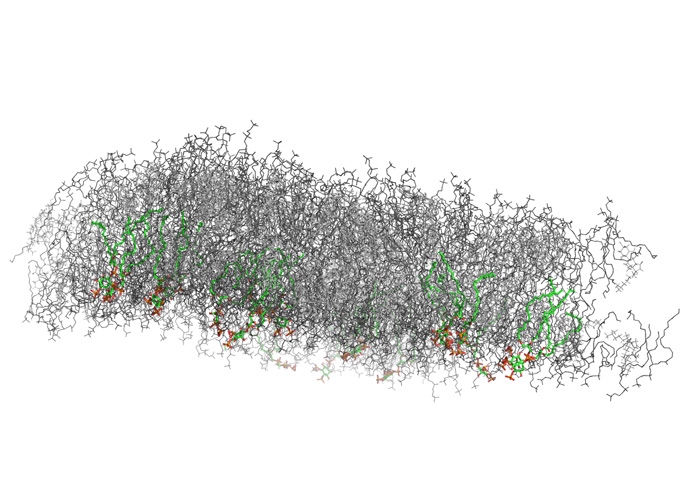
Model of a pure lipid membrane. ©Helmholtz Zentrum München/Dr. Ünal Coskun
Cell membranes are constantly subjected to extensive compositional remodelling in response to environmental challenges. Scientists from Max-Planck Institute for Cell Biology and Genetics and Helmholtz Zentrum München published a new method in the journal ‘Analytical Chemistry’, which for the first time allows to quantify the absolute abundance and the turnover rate of lipid species by direct analysis of total lipid extracts.
While state of the art mass spectrometry methods would allow for the quantification of total lipid composition, the time dependent turnover of lipid species was not accessible to date. Thus, there is a need for generic and accessible analytical tools that combine full-lipidome quantification with simultaneous monitoring of the turnover, the flux, of individual lipids.
In a close collaborative work with scientists from Max-Planck Institute for Cell Biology and Genetics (MPI-CBG) and École polytechnique fédérale de Lausanne (EPFL), scientists of the Institute for Pancreatic Islet Research (IPI) of Helmholtz Zentrum München in Dresden succeeded in the development of a shotgun ultra-high-resolution mass spectrometry (sUHR) method, which for the first time enables to quantify the absolute abundance and determine the turnover rate of lipid species by direct analysis of total lipid extracts.
Lipid profiles can be correlated with health and disease states
“Although existing analytical technologies could quantify major lipids in one snapshot acquired at any given time, it was difficult to monitor a “concealed” lipid remodelling that does not change their overall quantities” explains Dr. Andrej Shevchenko, group leader at MPI-CBG, “therefore, we joined forces with Dr. Ünal Coskun at IPI/PLID to develop a simple and efficient method to monitor the lipid dynamics using ultra-high-resolution mass spectrometry.”
“When we think of lipids we intuitively think of dietary lipids in the context of obesity and various diseases like diabetes, or we think of the few clinical markers: cholesterol, triglycerides and lipoprotein particles” says Dr. Ünal Coskun. The lipid world, however, is more complex. Cells synthetize and turn over several thousands of different lipids. Membrane lipids are of paramount importance for the direct regulation of membrane receptors and their cellular signalling activities. In essence, cellular live is unthinkable without membrane lipids. “The new method for the first time allows us to quantitatively follow every detectable lipid and to correlate it with health and disease states. Moreover, the quantitative nature of the method is key for standardization and thus translations into clinical applications in the future.”
Press Release of the Helmholtz Zentrum München - German Research Center for Environmental Health
Kai Schuhmann, Kristina Srzentić, Konstantin O. Nagornov, Henrik Thomas, Theresia Gutmann, Ünal Coskun, Yury O. Tsybin, and Andrej Shevchenko: Monitoring Membrane Lipidome Turnover by Metabolic 15N Labeling and Shotgun Ultra-High-Resolution Orbitrap Fourier Transform Mass Spectrometry. Analytical Chemistry, DOI: 10.1021/acs.analchem.7b03437 (2017)